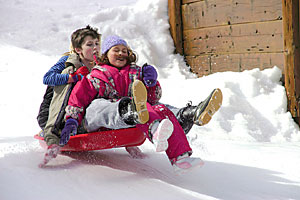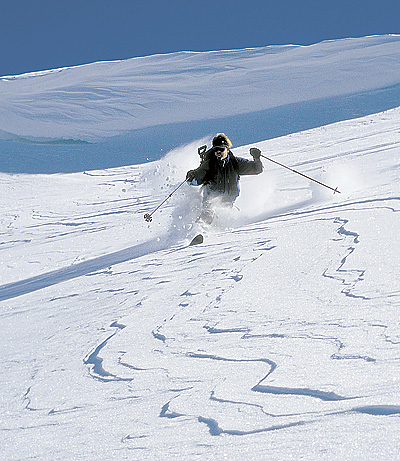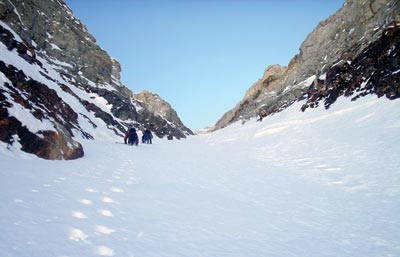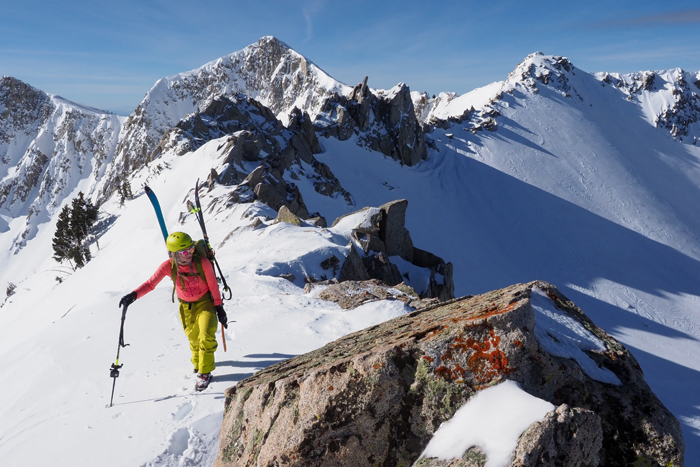- Tahoe’s Nevada Beach Tops the List of Hard-to-Book Campgrounds - 07/17/2024
- Cannabis Watershed Protection Program Cleans Up Illegal Grow Sites - 07/10/2024
- French Fire - 07/05/2024
By Pete Gauvin
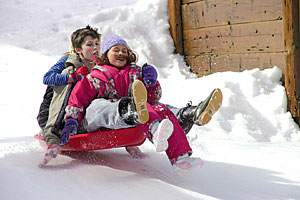
Photo by Suzanne Lucas
Of the three passes that climb over the Sierra in winter, Carson Pass is the highest (8,574 feet), most spectacular and least trafficked. Drive up on a sun-splashed winter morning with glittering fresh snow and you’ll be overcome with feelings of alpine lust.
The band of volcanic cliffs rising a couple thousand feet above Silver Lake … The view of the Crystal Range from the precipitous Carson Spur roadcut … The aspen groves above Caples Lake … The above tree-line flanks of Round Top peak … The snow-blanketed meadows of Hope Valley.
These scenes and more will crystallize your allure for this unspoiled high-country getaway. Although only about a half-hour drive south of the glitz, motels and one-armed bandits of South Lake Tahoe, this area is a world apart in ambiance.
The First Crossing
John C. Fremont was taken by the area, too. On Feb. 14, 1844, he ascended a high, unnamed peak (now known as Red Lake Peak), from which he is credited with the first glimpse of Lake Tahoe. “ … We had a beautiful view of a mountain lake at our feet, about 15 miles in length, and so entirely surrounded by mountains that we could not discover an outlet,” he wrote.
The leader of an expedition for the U.S. Topographical Engineers, Fremont was in the midst of the first winter traverse of the Sierra by white men. Despite being warned by indigenous Washoe Indians not to cross the mountains in winter, they decided to forge ahead because their provisions were low and they hoped to resupply in the Sacramento Valley. In a pep talk to his men, Fremont assured them that they would “place themselves in the midst of plenty.”
The snows were deep and they endured several storms and below-zero nights, but Fremont was still enchanted by the landscape. “… If we could be free of the many anxieties that oppress us, even now we would be delighted here; but our provisions are getting fearfully scant.”
As it was, they had to resort to eating horse, mule and dog en route. Although it was an ordeal, the party made the journey in 30 days without losing any men. (Of the 67 horses and mules, however, only 33 reached the destination, Sutter’s Fort.) Fremont named the pass in honor of his scout, Kit Carson.
Had Fremont’s party encountered more severe weather, they may not have been so fortunate. Two years later, a group trying to make a similar winter crossing north of Lake Tahoe were stranded by heavy early-season snows; 34 of the 81 members perished. They’re immortalized as the Donner Party.

Photo by Micheal Camargo
Planks on Snow
Today, the heavy snows that Fremont’s party was, for the most part, lucky to avoid are exactly what draw so many skiers/boarders to the Carson Pass area. No matter how you like your skiing served – downhill, cross-country or backcountry – Carson Pass offers some of the best terrain and snow conditions in the Sierra. Most of it is easily accessible, too, making it a prime destination for weekend jaunts.
For challenging lift-served skiing, Kirkwood is hard to beat. Set in a horseshoe-shaped canyon just off Highway 88, Kirkwood boasts the highest base elevation (7,800 feet) and deepest average snowfall among California resorts. Although one of the closest major resorts to the Bay Area, Kirkwood’s snow is often lighter and deeper than other Tahoe resorts. With 2,300 acres of terrain ranging from precipitous chutes to long backside cruisers, there are runs catering to all abilities.
Cross-Country
Next door, Kirkwood Cross County offers 80km of groomed trails amid spectacular alpine scenery. A cozy lodge and trailside warming huts provide refuge from the elements. Dogs are allowed on two trails.
Fourteen miles east on Highway 88, the Hope Valley Outdoor Center, next to Sorensen’s Resort, has 100km of skier-packed trails (no, that doesn’t mean they’re crowded) ranging from wide-open meadows to forested ridges. Ask Joyce, the owner, for the best trail suggestions. (Apres note: The café has some good beers on tap.)
On Jan. 7, the Outdoor Center (530-694-2266) will host a free event to introduce folks to XC skiing and snowshoeing as part of Winter Trails Day. The event is part of a hundred such events taking place in the U.S. and Canada.
Backcountry
Backcountry enthusiasts have a bounty of options on Carson Pass. The best earn-your-turn adventures start from the Sno-Park lots near the summit. From the north-side lot, it’s a three-mile ski to the summit of Red Lake Peak (10,061 feet). Unlike John C. Fremont, you can enjoy a number of descent options without fear of starvation.
To the south, broad-shouldered Round Top (10,380 feet) dominates the horizon. It provides good downhill terrain for snowboarders and skiers. Just east of the summit, the Red Lake turnout on Highway 88 is a launch point for several other tours. Follow the unplowed road south to Forestdale Creek; the bowl on the right often has excellent powder.
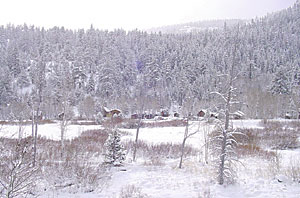
Sorensen’s Resort.
Photo by Michael Camargo
Hot Springs
For warm soaks in a wintry setting, Grover Hot Springs State Park on the east side is open year round, even during blizzards – if you can get there. The park is four miles west of Markleeville in an alpine meadow at 5,900 feet. Call (530) 694-2249 for pool hours.
Lodging
No place exemplifies the charm of the Carson Pass area more than Sorensen’s Resort. A collection of two dozen rustic log cabins interspersed with aspen trees, Sorensen’s has the feel of a Norwegian village. You can ski right from your cabin door – to the backcountry or dinner. Cabins accommodate two to six people. A cozy café serves breakfast, lunch and dinner, and the gift shop has an assortment of wines and interesting books. (1-800-423-9949, www.sorensensresort.com)
Other options in the area include Kirkwood, Caples Lake Resort, and the Woodfords Inn. For a backup option, South Lake Tahoe has about 22,000 rooms.

